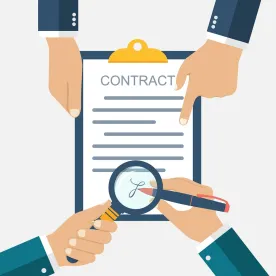United States Patent and Trademark Office (USPTO) regulations allow for electronic signatures, but certain formalities must be followed. They have become more important as so many company employees are working from home.
The USPTO allows signing of most correspondence by use of a so-called S-signature, per the 2004 Changes to Support Implementation of the United States Patent and Trademark Office 21st Century Strategic Plan and in 37 CFR 1.4(d). An S-signature includes any signature made by electronic or mechanical means, and any other mode of making or applying a signature other than a handwritten signature.
Importantly, the S-Signature is defined by the existence of a set of surrounding forward slash marks. A person signing correspondence must insert his or her own S-signature between a single forward slash mark before and a second single forward slash mark after the signature. The slashes are critical. What is not critical is who makes the slash marks.
The signatory need not make the slash marks as part of the S-signature. Rather, the slash marks may be placed within the signature block prior to or after execution. The slash marks are necessary indications of an S-signature, but themselves do not form part of the signature itself.
Moreover, document signing services may be used to create an efficient workflow for electronic signature of USPTO documents during shelter-in-place restrictions. Services such as those offered by DocuSign® offer an ability to provide an electronic signature on a variety of devices. Therefore, for execution of USPTO documents, either an electronic image captured from enabling services, for example DocuSign®, or a typewritten name is acceptable; it must include the slashes:
/ DOCUSIGN /
or
/ John P. Doe /
Moreover, when considering inventor assignment documents, an electronic signature is effective for transferring patent rights. The statutory basis for assignment may be found at 35 USC §261, which provides that the rights of an inventor are personal property that may be assignable in law by an instrument in writing. Under the Uniform Electronic Transactions Act (UETA), personal property, including patent rights, may be transferred using a compliant electronic signature. Forty-seven states and the District of Columbia, Puerto Rico, and the Virgin Islands have adopted the UETA. Three states –New York, Illinois, and Washington – have adopted alternatives to the UETA, and each allows for the transfer of patent rights using a compliant electronic signature. The same format of the electronic image is required and capturing it from an enabling service such as DocuSign® offers an efficient workflow for inventor assignments, as well.
Until recently, the USPTO required actual handwritten, ink signatures in only two instances: 1) correspondence requiring a person's signature and relating to registration to practice before the Patent and Trademark Office in patent cases, enrollment and disciplinary investigations, or disciplinary proceedings; and 2) payments by credit cards where the payment is not being made via the USPTO’s electronic filing systems. In March 2020, in light of the effects of COVID-19, the USPTO announced a waiver in March 2020 of the requirements of 37 CFR 1.4(e) and will accept copies of handwritten signatures in both circumstances. For these two instances, however, the USPTO does not accept the S-signature format discussed, but rather allows for a copy of a handwritten, ink signature rather than an original signature.





 />i
/>i

